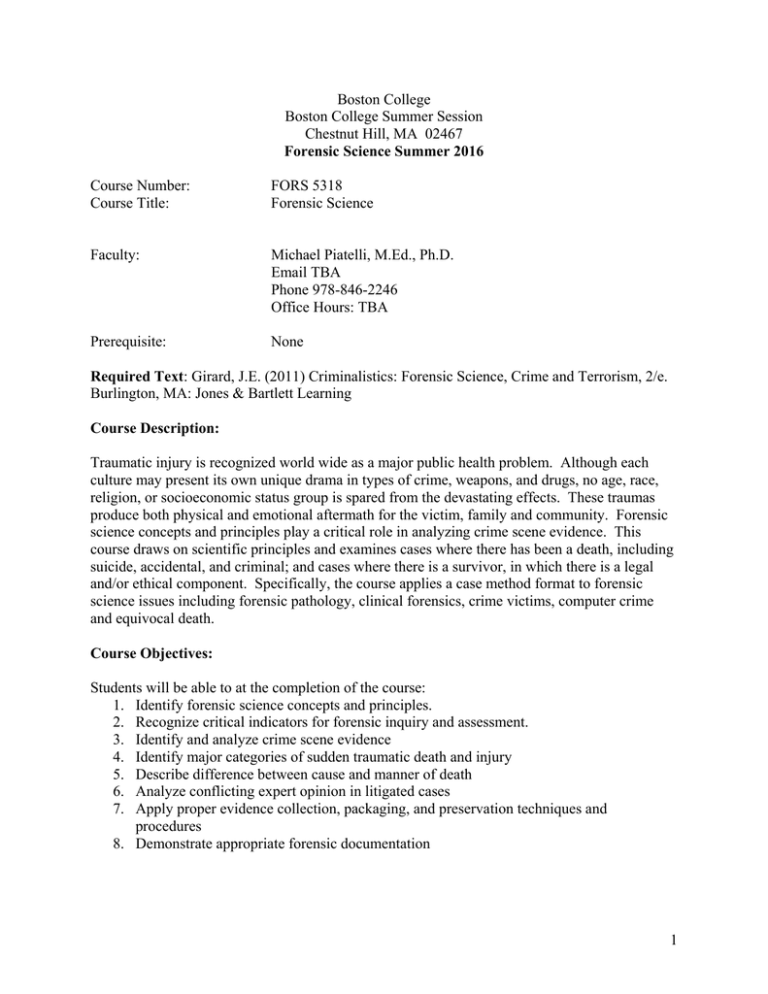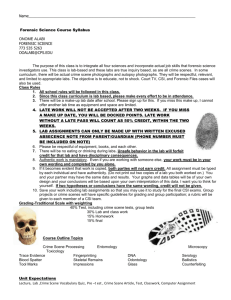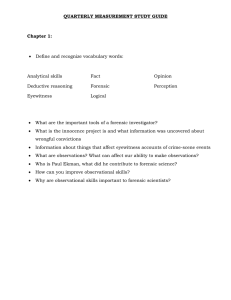Boston College Boston College Summer Session Chestnut Hill, MA 02467 Course Number:
advertisement

Boston College Boston College Summer Session Chestnut Hill, MA 02467 Forensic Science Summer 2016 Course Number: Course Title: FORS 5318 Forensic Science Faculty: Michael Piatelli, M.Ed., Ph.D. Email TBA Phone 978-846-2246 Office Hours: TBA Prerequisite: None Required Text: Girard, J.E. (2011) Criminalistics: Forensic Science, Crime and Terrorism, 2/e. Burlington, MA: Jones & Bartlett Learning Course Description: Traumatic injury is recognized world wide as a major public health problem. Although each culture may present its own unique drama in types of crime, weapons, and drugs, no age, race, religion, or socioeconomic status group is spared from the devastating effects. These traumas produce both physical and emotional aftermath for the victim, family and community. Forensic science concepts and principles play a critical role in analyzing crime scene evidence. This course draws on scientific principles and examines cases where there has been a death, including suicide, accidental, and criminal; and cases where there is a survivor, in which there is a legal and/or ethical component. Specifically, the course applies a case method format to forensic science issues including forensic pathology, clinical forensics, crime victims, computer crime and equivocal death. Course Objectives: Students will be able to at the completion of the course: 1. Identify forensic science concepts and principles. 2. Recognize critical indicators for forensic inquiry and assessment. 3. Identify and analyze crime scene evidence 4. Identify major categories of sudden traumatic death and injury 5. Describe difference between cause and manner of death 6. Analyze conflicting expert opinion in litigated cases 7. Apply proper evidence collection, packaging, and preservation techniques and procedures 8. Demonstrate appropriate forensic documentation 1 Teaching-Learning Methods: A lecture-discussion format will be used to present information. Lectures will include guest lecturers, PowerPoint presentations and videotaped materials. Content will be taught by case study method to develop student skills in the analysis of crime scene evidence. Students are expected to be current on contemporary crime cases covered in the local and national media. Guest lecturers will present some of the content and class topics may be changed to accommodate the lecturer’s schedule. Students are required to complete all readings and be prepared to engage in interactive dialogue initiated by the course instructor/guest lecturer. Students are also expected to actively participate in in-class discussion. The weekly Internet case research derives from Professor Burgess’s court cases over the years. Students will prepare a short essay (1 page) of questions and reactions to the case(s) for class discussion and debate. The focus of the case is from the evidence or forensic science perspective. The paper is due with the weekly in-class work. Student Evaluation Methods: 2 in-class exams on lecture handouts and text chapters 1 written paper Weekly in-class work on text chapters plus opinion of presented cases and prepared question(s) and reaction to the Internet case research. Attendance on time for lectures is expected in Nursing 315. The student is responsible for any missed class materials and information presented in lecture. Participation in in-class work documents attendance. Exams There will be two examinations given this semester. The examinations consist of multiple choice and/or matching items. Material covered on the exams will include content from the lectures. Paper Students will be required to write one paper choosing one of the following topics. All students are required to cite all sources used in the preparation of the paper. Paper A: TV Crime Scene Investigation Reaction Paper Several TV shows focus on crime or crime scene investigation. Select one show, e.g. CSI, Law and Order, etc. and invite an associate to watch it with you. Write a reaction paper about it from the following perspective. 1. Describe the crime. (15 points) 2. Using terms and concepts taught in class, describe the evidence and how it was processed. (30 points) 2 3. Describe the media message of the show from your perspective and from your associate’s perspective. (20 points) 4. Contrast your reaction to the outcome of the case with your associate’s reaction. (10 points) 5. Describe the influence (or not) this class had on your understanding of the crime and its outcome (in contrast or in concert with your associate’s views). (20 points) 6. Paper format, including organization, spelling, grammar and sentence structure (5 points) Paper B: Evidence Analysis Paper Select a specific criminal case via the newspaper or worldwide web. Note the source of your case. Analyze the case from the evidence presented. 1. Describe the crime in terms of location, victim, offender, etc. (30 points) 2. Using terms and concepts taught in class, describe the crime scene evidence. (30 points) 3. Describe the testimony to support the evidence and describe the testimony to refute the evidence. (15 points) 4. Describe the outcome of the case as it relates to the crime scene evidence. (20 points) 5. Paper format, including organization, spelling, grammar and sentence structure (5 points) Students must use appropriate sources for their paper. Sources such as personal web sites and wikipedia.org are not appropriate sources. Appropriate sources include: Internet research taken from newspapers, journal articles, as well as class lectures, and the text. Please note that in preparing your paper, you must relate the topic of your paper to the concepts and terms discussed in class and in the readings. Also, each paper must be presented in an appropriate format, (APA or MLA), and references and terms must be cited accordingly, even those terms taken from the lectures and the readings. Page limits (8-10 pages) are relatively firm (give or take a line or two). Make points clearly and succinctly – a skill that can be honed. Provide an introductory paragraph (roadmap) that outlines briefly what you did in the paper. ABOVE ALL your paper should reflect that this is a FORENSIC SCIENCE course thus the implications for forensic science should be apparent. All papers MUST use 1 inch margins and 12 point font. Please note that page limits do not include references. Course Grade: 30% for each exam 30% for paper 3 Points for quizzes can increase or decrease the final grade point Research credit is given for participation in any survey/questionnaire studies offered during the semester. Class participation Attendance (departure at half-time will be noted as will frequent absences). Evidence of completion of assigned readings with critical appraisal (able to discuss the nuances of arguments or stances and provide supporting evidence of your points of agreement and disagreement). Balanced contributions to class discussions (succinct, reasoned, points and counterpoints) Course Evaluation: University Evaluation Form Course Policies: Students are expected to follow the policy on academic integrity listed in the catalogue and available from BCSON graduate administrative office. Students with a disability who may require special accommodations during the course need to notify the TOR no later than the second week of class. Students are expected to take the exams at the designated time. In the event of an undesignated absence, the TOR must be notified and the reason for the absence discussed as soon as possible. The examination will be re-scheduled at the discretion of the TOR if the cause of is deemed unavoidable. 4 Forensic Science Syllabus Reading/Internet Research Videos Topic Criminalistics Crime scene investigation Girard: Ch. 1 Jeffrey Duke murder #1 simulation Processing Physical Evidence Soil Internet research case: Arizona Buddhist temple murders retrial Firearms & Ballistics Internet research case: State v Cornelius Nobles http://www.aoc.state.nc.us/w ww/public/sc/opinions/2003/1 56-98-2.htm Girard:Ch. 2, 3 Boston Crime Lab Trace evidence Internet research case: Heitholt/Ferguson “Under a Killing Moon” by Dateline http://www.nbcnews.com/vid eo/dateline/50034612#500346 12 Girard: Ch. 5, 8, 9 Fingerprints Hair and Fibers Glass Internet research case: Polly Klass/Richad Allen murder case Biological Evidence/fluids Blood spatter Internet research case: Dawn Cruickshank http://ny.findacase.com/resear ch/wfrmDocViewer.aspx/xq/f ac.19850117_0040364.NY.ht m/qx Exam 1 on Classes 1-6 Anthropology/Entymology Questioned Documents Girard: Ch. 4,5,6 Broward crime scene “Ring Him Up” Cannon case Jeffrey Duke double murder simulation Girard: Ch. 4 “Chief Suspect” Guest Lecturer: Dr. Allen Burgess, Data Integrity, Inc. Guest Lecturer: Emily Ross, Crime Analyst, Boston Crime Lab Virtual Crime Case: Tinsel Man “Shattered Dreams" Guest Lecturer: Det. Sgt. Eugene Neault, BC Police (ret.) Girard: Ch. 13 Guest Lecturer: Dr. Michael Piatelli, Merrimack College Virtual Crime Case: Jason Williford Girard: Ch. 11 “Killer 5 Impression” Internet research case: John Wayne Gay; Lindburgh kidnapping Medicaid Fraud cases & Forensics Computer Related Crime Identity Theft Internet research case: Edward Snowden; Bradley Manning DNA Forensic Toxicology Internet research cases: Scott Peterson; Lynette White/Jeffrey Gafoor; Kirk Bloodsworth; Gary Dotson; Alejandro Avila; John Belushi PAPER DUE Arson/Bombing Terrorism/Explosives Girard: Ch. 7 “Strikers Pond” Guest lecturer: Nancy Barsamian, BSN, MPH Nurse Consultant, Attorney General’s Office, Boston Girard: Ch. 15 Guest Lecturer: Dr. Allen Burgess, Data Integrity, Inc. “Small Town Terror” Girard: Ch. 12, 14 Guest Lecturer: Dr. Michael Piatelli, Merrimack College Virtual Crime Case: Z Case Girard: Ch. 10, 16, “Wired for Disaster” Internet research case: Victor Caminata, MI Thanksgiving Holiday. No class Bioterrorism Microbial forensics Internet research case: JFK Assassination Exam 2 Girard: Ch. 17 Handcuff case **The order of lectures is subject to change based on the availability of guest lecturers. 6






